You might have encountered different types of black spiders in the house, garden, yard, or woodland forest. But it can be challenging to tell whether the spiders are poisonous or not.
Identifying these black spiders will help alleviate the phobia associated with them. Many people associate black spiders with venomous species due to their scary appearance and spikes on the body.
Do not panic when you notice small black spiders scurrying across the floor in your house. This guide will help you identify the most common types of black spiders you’re likely to encounter at home or in the backyard.
How to Identify Black Spiders (Identification Guide)
Identifying black spiders may sound simple, but you need to know a thing or two before concluding. Here are quick tips for identifying types of house spiders:
Body Markings
Most black spiders have an all-black body or black body with colored markings. Black spiders with white stripes on their legs are rare compared to those with all-black bodies.
Hairs or Spikes
The presence of hairs and spikes on the legs or body make black spiders appear dangerous. But these features help scare away potential predators in their habitats.
Number of Legs
Black spiders belong to the Arachnida class since they have eight legs. The black spider legs are longer than the body.
Body Segments
Black spiders have two segments (cephalothorax and abdomen). Most arthropods with two body parts belong to the Arachnida class.
Different Types of Black Spiders with Pictures
Most black spiders belong to different families and species. We recommend using the black spider species for easy identification. (Source: University of Kentucky). Below is a quick list of black spiders with pictures and names:
Wasp Spider (Argiope bruennichi)

It is a black spider with a fuzzy white cephalothorax and yellow banded legs. It can be challenging to differentiate this black spider species from the yellow and black garden.
The wasp spider has straight legs and a stripy body. The female spider grows up to 1.5cm, and the male counterpart can reach 0.4cm long.
The black, yellow, and white bands around the abdomen are the prominent features for identifying wasp spiders. The long spindly legs also have yellow and black bands.
| Appearance | Wasp spiders have long straight legs with yellow and black bands. The abdomen has white, yellow, and black bands. |
| Native Region | Europe, North Africa, and parts of Asia. |
| Habitat | Grassland, Farmland, Gardens, Woodland, and Heathland |
| Threat | Non-aggressive by can sting when threatened. |
| Unique Facts | Female wasp spiders make the largest egg sacs than other species. |
Redback Spider (Latrodectus hasselti)

It is a tiny black spider with red markings on its rounded abdomen. The redback spiders have long spindly back legs and measure about 1cm.
The round abdomen is smooth and black with red or orange markings. These spider species have nasty bites that can cause severe skin pain.
Female redback spiders do not attack people, but they bite if threatened. The red strips on the round and smooth black abdomen are ideal for identification.
| Appearance | The smooth black abdomen has red or orange markings. |
| Native Region | Australia |
| Habitat | Dark and dry areas like logs or under the rocks. |
| Threat | Cause severe illness and even deaths |
| Unique Facts | Male redback spiders never find a mate |
Salticus Palpalis
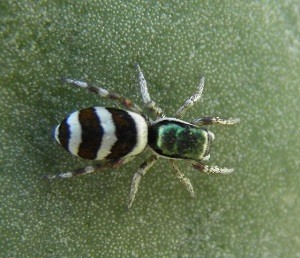
It is a tiny furry black zebra spider with jumping abilities. The salticus palpalis has an iridescent cephalothorax with shimmering green colors.
These black spiders have eight black furry legs with black spines and markings. The copper-red abdomen with white bands is ideal for easy identification.
A mature salticus palpalis measures about 0.5cm long. These spiders love living in tree trunks and under the rocks near sunny areas.
| Appearance | Has a copper-red abdomen with white bands and a shimmering green cephalothorax. |
| Native Region | North America |
| Habitat | Tree trunks and rocks in woodlands or heathlands. |
| Threat | Rarely bite and do not carry venom |
| Unique Facts | Active during the daytime due to sunlight. |
Purseweb Spider (Atypus affinis)
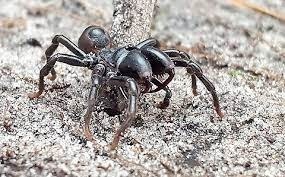
It is a small spider with a brownish or black body that resembles tiny tarantulas. The shiny bodies do not have red markings underside of the spider.
The purseweb spiders are aggressive with harmless bites. Female black spiders grow up to 1.5cm, and the male counterparts are smaller.
These black spider types dwell under the plant debris and fallen leaves. It can be challenging to spot purseweb spiders in the house.
| Appearance | Shiny black body with fangs pointing downwards. |
| Native Region | South Tennessee, North Ontario, and Kansas. |
| Habitat | Dwell under plant debris and fallen leaves. |
| Threat | Harmless bites |
| Unique Facts | Not related to wolf spiders despite resembling each other. They are very primitive spider species. |
Carolina Wolf Spider (Hogna carolinensis)
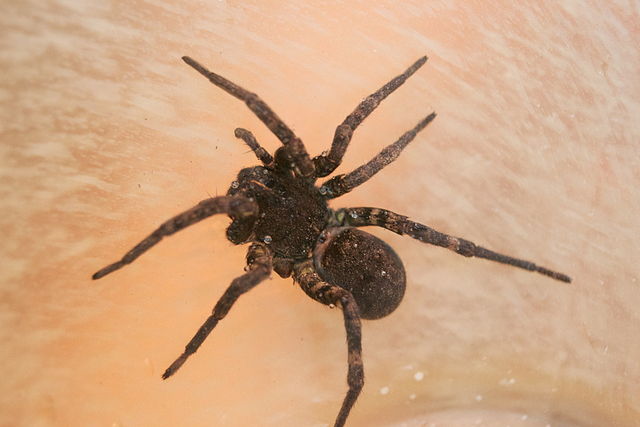
It is the largest wolf spider in the United States of America. These spider species have a gray body with black undersides.
The females are bigger than the male spiders. Besides that, female Carolina wolf spiders have all-black bodies with black legs.
| Appearance | Has a gray body with black undersides |
| Native Region | North America |
| Habitat | Grasslands, fields, pastures, and deserts |
| Threat | Venomous bites |
| Unique Facts | Largest among wolf spiders in North America. |
Tigrosa Georgicola
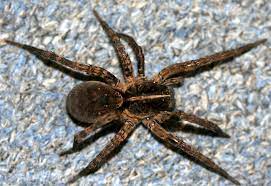
It has a black body with brown patterns that resemble the tiger. Tigrosa georgicola spiders live in solitary and do not spin webs.
These black spiders have excellent vision to help the different object colors. They are non-aggressive although they can inject venom when biting.
| Appearance | Black body with brown patterns resembling a tiger. |
| Native Region | Southern USA |
| Habitat | Forest floors |
| Threat | Poisonous bites |
| Unique Facts | Do not spin webs for catching prey |
Black Widow Spider (Latrodectus spp.)
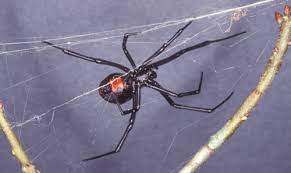
It is a tiny black spider has red markings underside, a large round abdomen, and spindly legs. Black widow spiders grow between 0.3cm and 1.0cm long. These spiders have poisonous bites that can damage the central nervous system.
The black spider poison can cause muscle pains, racing heartbeat, muscle spasms, and abdominal cramps. Severe black widow spider bites can cause long-lasting effects.
These black spiders dwell under the woodpiles and can be brought into the building by firewood. They also hide in the cardboard crevices, footwear, and basement.
| Appearance | Have a large round body with spindly legs and red markings underside. |
| Native Region | North America, Asia, and South Africa |
| Habitat | Woodpiles |
| Threat | Poisonous bites |
| Unique Facts | Venom is 15 times more toxic than rattlesnake poison. Only adult spiders have dangerous bites. |
Black House Spider (Badumna insignis)

It is a small black spider with a dark chocolate body and relatively fat legs. Male and female black house spiders have dark bodies and velvet hairs.
These spider species have poisonous bites, although they are less aggressive. A black house spider bite will cause pain and skin irritation.
Black house spiders dwell in the wall crevices, window frames, rough bark trees, woodpiles, and doorway corners.
| Appearance | Have a dark chocolate-gray body with relatively fat legs. |
| Native Region | Australia, Japan, and New Zealand |
| Habitat | Woodpiles, rough tree barks, wall crevices, and window frames. |
| Threat | Poisonous bites. |
| Unique Facts | Timid spiders with infrequent bites. |
White-Tailed Spider (Lampona cylindrata)
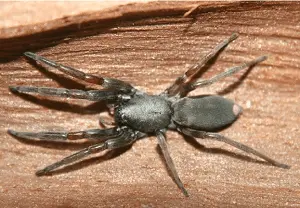
It has a slender blackish cephalothorax and abdomen with reddish brown legs. The white tip on the abdomen is a prominent feature for easy identification.
White-tailed spiders hail from Australia and dwell in the garden or houses. They prefer darker spots indoors or outdoors. The bites can cause itching, swelling, and pain.
| Appearance | Black thorax and abdomen with reddish brown legs. It also has a white tip on the rear abdomen. |
| Native Region | Australia |
| Habitat | Garden and houses |
| Threat | Venomous bites |
| Unique Facts | Venomous bites that are not dangerous |
Noble False Widow (Steatoda nobilis)

It is a tiny brownish-black spider with reddish-brown legs. This small black spider also has a black brown thorax and gray bulbous abdomen with black markings.
Noble false widow spiders are invasive since they can invade homes. The population will increase rapidly to pose danger to humans.
They can give nasty bites that cause severe pain. Noble false widow spiders hail from Europe and they are the most dangerous.
| Appearance | Brownish-black spider with reddish-brown legs. |
| Native Region | Europe |
| Habitat | House and garden |
| Threat | Poisonous bites |
| Unique Facts | Resemble the most lethal black widow spiders |
Red and Black Spider (Nicodamus peregrinus)
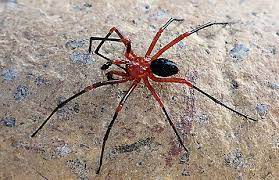
The spider has a black abdomen with a coppery-red thorax that contrasts the red-black legs. These black spider species have long legs and harmless bites.
Red and black spiders hail from Australia. Do not let the vibrant red coloring freak you out since these are among the scariest black spiders that are harmless.
| Appearance | Has a black abdomen with coppery-red thorax and red-black legs. |
| Native Region | Australia |
| Habitat | Garden and houses |
| Threat | Harmless bites |
| Unique Facts | Females can lay over 3500 eggs in their lifetime. |
Easter Parson Spider (Herpyllus ecclesiasticus)

It is a medium-sized hairy spider with a black body, reddish-brown legs, and white longitudinal bands in the middle. The harmless bites can cause allergic reactions.
Easter parson spiders dwell in the rocks, logs, and garden debris. These black spiders intrude on the homes during cold weather.
| Appearance | Has a black body with white longitudinal bands in the middle and reddish-brown legs. |
| Native Region | Central USA |
| Habitat | Rocks, logs, and garden debris |
| Threat | Harmless bites |
| Unique Facts | It roams on the ground and walls at night in search of insects. |
Funeral Wolf Spider
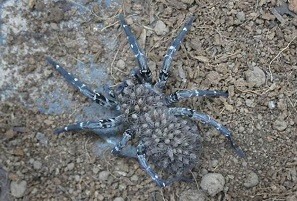
The dark-colored body is the reason for the name. The funeral wolf spiders are native to the United States of America.
A funeral wolf spider has a black head and a shiny black thorax. The abdomen is fully covered with brown hairs and the black legs are translucent.
| Appearance | Has a black abdomen with brown hair. The translucent legs have black and brown colors. |
| Native Region | North America |
| Habitat | Dense grass, tall shrubs, Leaf litter |
| Threat | Harmless bites |
| Unique Facts | Do not hunt with webs |
Zebra Jumping Spider (Salticus scenicus)
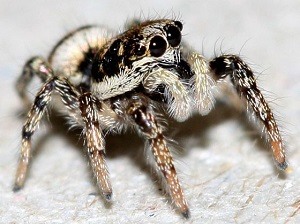
It is a furry black spider with white stripes. These black spider species have fuzzy abdomen, spiny legs, and large eyes.
The black and white zebra-like patterns are the reason for the name. They hunt their prey by stalking and pouncing on them.
| Appearance | Have a black furry abdomen with white stripes. |
| Native Region | Palearctic |
| Habitat | Tree trunks, shingles, and rocks |
| Threat | Harmless bites |
| Unique Facts | Do not use webs to hunt |
Bold Jumping Spider (Phidippus audax)
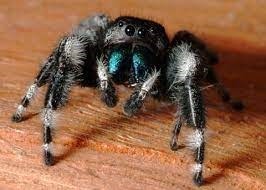
It is a jumping spider with a large round abdomen and gray bands. A juvenile bold jumping spider has orange markings that turn white at maturity.
The black furry spider also has iridescent mouthparts and flat faces. These predator spiders do not use webs to catch the prey.
These black spider species grow up to 1.8cm long with short striped legs. The bold jumping spiders resemble brown recluse spiders.
| Appearance | Fuzzy brown or black body spiders with iridescent fangs. |
| Native Region | Canada and west California |
| Habitat | Grassland and open woodlands |
| Threat | Harmless bites. |
| Unique Facts | Use venom to paralyze prey. |
Gray Wall Jumping Spider (Menemerus bivittatus)
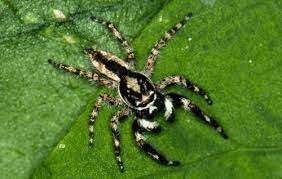
It is a hairy black spider with black and gray stripes. Some have white stripes running along the body and their fuzzy legs.
The gray wall jumping spiders measure about 1.2cm long. These oval-shaped black spiders have harmless bites that cause local pain only.
| Appearance | Have contrasting gray and black stripes on the body. |
| Native Region | Florida, California, Texas, Paraguay |
| Habitat | Crevices of walls |
| Threat | Harmless bites |
| Unique Facts | The eyes can focus on objects and detect colors. |
Spiny Orb-Weaver Spider (Gasteracantha cancriformis)
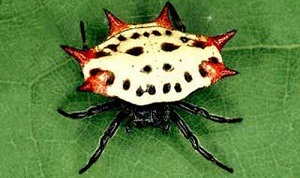
It is a colored black spider with a black-spotted abdomen and six spines. The brightly colored disc-like abdomen can also be red, yellow, or white.
Some spiny orb-weaver spiders have a white upper side with red or black spines. These black spiders spin large webs to catch the prey.
| Appearance | Have a circular disc-like abdomen with black spots and six spines. |
| Native Region | California |
| Habitat | Woodlands and shrubby gardens |
| Threat | Harmless bites |
| Unique Facts | Intimidating species with harmless bites |
Red-Backed Jumping Spider (Phidippus johnsoni)
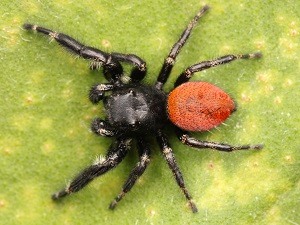
It is a harmless shiny black spider with black legs, robust cephalothorax, and a bright red abdomen. Female spiders have a central black stripe on the red abdomen.
The red-backed jumping spiders measure about 1.4ccm long. These spiders do not spin webs to catch their prey.
| Appearance | Contrasting jet-black cephalothorax and bright red abdomen. |
| Native Region | The Pacific Ocean, great plains, southern Canada, and northern Mexico |
| Habitat | Oak woodlands and coastal dunes |
| Threat | Harmless bites |
| Unique Facts | Male spiders assist female counterparts in sexual cannibalism |
Woodland Giant Wolf Spider (Tigrosa aspersa)

It is the largest wolf spider type that measures about 25mm. The spider has a black thorax, head, and abdomen with yellow markings.
The woodland giant wolf spiders have legs with yellow-brown and black markings. It also has a tiger-like physical appearance.
| Appearance | Black with yellow markings. |
| Native Region | Eastern united states |
| Habitat | Rocks, logs, fallen leaves, and plant debris |
| Threat | Harmless bites |
| Unique Facts | Do not hunt with webs. Chase the prey and pounce on it. |
Black and Yellow Garden Spider (Argiope aurantia)
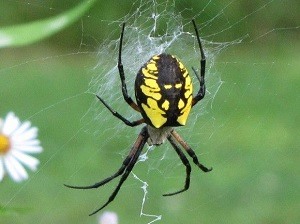
It is a big black spider with an oval black abdomen and yellow markings. The spider also has a white cephalothorax with the identifiable silhouette of an X-shape.
The black and yellow garden spider is also called a zigzag spider, golden garden spider, writing spider, and zipper spider.
| Appearance | Has a black body with yellow markings on the abdomen. |
| Native Region | Maryland |
| Habitat | Dense shrubs or houseplants |
| Threat | Harmless bites |
| Unique Facts | Sense prey vibration on the webs |
People Who Read This Also Read:
